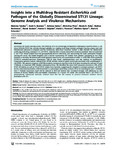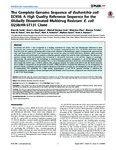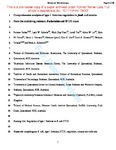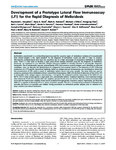Insights into a Multidrug Resistant Escherichia coli Pathogen of the Globally Disseminated ST131 Lineage: Genome Analysis and Virulence Mechanisms

Date
2011-10-28Author
Subject
Metadata
Show full item recordAbstract
Escherichia coli strains causing urinary tract infection (UTI) are increasingly recognized as belonging to specific clones. E. coli clone O25b:H4-ST131 has recently emerged globally as a leading multi-drug resistant pathogen causing urinary tract and bloodstream infections in hospitals and the community. While most molecular studies to date examine the mechanisms conferring multi-drug resistance in E. coli ST131, relatively little is known about their virulence potential. Here we examined E. coli ST131 clinical isolates from two geographically diverse collections, one representing the major pathogenic lineages causing UTI across the United Kingdom and a second representing UTI isolates from patients presenting at two large hospitals in Australia. We determined a draft genome sequence for one representative isolate, E. coli EC958, which produced CTX-M-15 extended-spectrum β-lactamase, CMY-23 type AmpC cephalosporinase and was resistant to ciprofloxacin. Comparative genome analysis indicated that EC958 encodes virulence genes commonly associated with uropathogenic E. coli (UPEC). The genome sequence of EC958 revealed a transposon insertion in the fimB gene encoding the activator of type 1 fimbriae, an important UPEC bladder colonization factor. We identified the same fimB transposon insertion in 59% of the ST131 UK isolates, as well as 71% of ST131 isolates from Australia, suggesting this mutation is common among E. coli ST131 strains. Insertional inactivation of fimB resulted in a phenotype resembling a slower off-to-on switching for type 1 fimbriae. Type 1 fimbriae expression could still be induced in fimB-null isolates; this correlated strongly with adherence to and invasion of human bladder cells and bladder colonisation in a mouse UTI model. We conclude that E. coli ST131 is a geographically widespread, antibiotic resistant clone that has the capacity to produce numerous virulence factors associated with UTI.
Collections
Publisher
Place of Publication
Journal
Volume
Issue
Pagination
Number
Recommended, similar items
The following license files are associated with this item:
Related items
Showing items related by title, author, creator and subject.
-
The Complete Genome Sequence of Escherichia coli EC958: A High Quality Reference Sequence for the Globally Disseminated Multidrug Resistant E. coli O25b:H4-ST131 Clone
Forde, BM; Ben Zakour, NL; Stanton-Cook, M; Phan, M-D; Totsika, M; Peters, KM; Chan, KG; Schembri, MA; Upton, Mathew; Beatson, SA (Public Library of Science (PLoS)United States, 2014-08-15)Escherichia coli ST131 is now recognised as a leading contributor to urinary tract and bloodstream infections in both community and clinical settings. Here we present the complete, annotated genome of E. coli EC958, which ... -
Comprehensive analysis of type 1 fimbriae regulation in fimB -null strains from the multidrug resistant Escherichia coli ST131 clone
Sarkar, S; Roberts, LW; Phan, M-D; Tan, L; Lo, AW; Peters, KM; Paterson, DL; Upton, Mathew; Ulett, GC; Beatson, SA; Totsika, M; Schembri, MA (WileyEngland, 2016-09-06)Uropathogenic Escherichia coli (UPEC) of sequence type 131 (ST131) are a pandemic multidrug resistant clone associated with urinary tract and bloodstream infections. Type 1 fimbriae, a major UPEC virulence factor, are ... -
Development of a prototype lateral flow immunoassay (LFI) for the rapid diagnosis of melioidosis.
Houghton, RL; Reed, DE; Hubbard, MA; Dillon, MJ; Chen, H; Currie, BJ; Mayo, M; Sarovich, DS; Theobald, V; Limmathurotsakul, D; Wongsuvan, G; Chantratita, N; Peacock, SJ; Hoffmaster, AR; Duval, B; Brett, PJ; Burtnick, MN; Aucoin, DP (United States, 2014-03)Burkholderia pseudomallei is a soil-dwelling bacterium and the causative agent of melioidosis. Isolation of B. pseudomallei from clinical samples is the "gold standard" for the diagnosis of melioidosis; results can take ...




